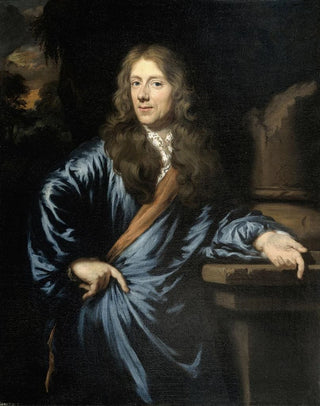Art print | Portrait of Willem Pottey, lawyer and accountant, general of Flushing - Nicolaes Maes


View from behind

Frame (optional)
Reproduction Portrait of Willem Pottey, lawyer and accountant, general of Flushing - Nicolaes Maes – Captivating Introduction
In the fascinating world of art, some works manage to capture the essence of an era while revealing the complexity of the individuals who inhabited it. The "Portrait of Willem Pottey, lawyer and accountant, general of Flushing" by Nicolaes Maes is one of those creations that, through its depth and realism, transports us to the heart of the Dutch Golden Age of the 17th century. Through this portrait, the artist does not merely depict a man; he invites us to explore the nuances of his character, the subtleties of his social status, and the environment surrounding him. This work, a true mirror of its time, thus becomes a window into the history and culture of the United Provinces.
Style and uniqueness of the work
Nicolaes Maes's style is distinguished by his ability to blend realism with psychological sensitivity. In the portrait of Willem Pottey, every detail, from the costume to facial expressions, is carefully crafted to convey a sense of life and dynamism. The play of light, characteristic of the Dutch school, creates an atmosphere that is both intimate and solemn. The choice of colors, often rich and nuanced, emphasizes the dignity of the subject while revealing elements of his personality. Maes manages to capture the viewer's gaze, establishing a silent dialogue between the portrait and its observer. This portrait is not limited to a simple representation; it becomes a visual narration, a story told through the features and gestures of Willem Pottey.
The artist and his influence
Nicolaes Maes, a pupil of Rembrandt, mastered his master's techniques while developing his own style, marked by a particular attention to detail and sensitivity to light. His career, which began in Rembrandt's workshop, was characterized by an evolution towards more varied themes, ranging from portraits to genre scenes. Maes established himself as one of the great masters of portraiture in the 17th century, influencing many artists of his time and future generations. His realistic and psychological approach to portraiture helped set a new standard in representation

Matte finish

View from behind

Frame (optional)
Reproduction Portrait of Willem Pottey, lawyer and accountant, general of Flushing - Nicolaes Maes – Captivating Introduction
In the fascinating world of art, some works manage to capture the essence of an era while revealing the complexity of the individuals who inhabited it. The "Portrait of Willem Pottey, lawyer and accountant, general of Flushing" by Nicolaes Maes is one of those creations that, through its depth and realism, transports us to the heart of the Dutch Golden Age of the 17th century. Through this portrait, the artist does not merely depict a man; he invites us to explore the nuances of his character, the subtleties of his social status, and the environment surrounding him. This work, a true mirror of its time, thus becomes a window into the history and culture of the United Provinces.
Style and uniqueness of the work
Nicolaes Maes's style is distinguished by his ability to blend realism with psychological sensitivity. In the portrait of Willem Pottey, every detail, from the costume to facial expressions, is carefully crafted to convey a sense of life and dynamism. The play of light, characteristic of the Dutch school, creates an atmosphere that is both intimate and solemn. The choice of colors, often rich and nuanced, emphasizes the dignity of the subject while revealing elements of his personality. Maes manages to capture the viewer's gaze, establishing a silent dialogue between the portrait and its observer. This portrait is not limited to a simple representation; it becomes a visual narration, a story told through the features and gestures of Willem Pottey.
The artist and his influence
Nicolaes Maes, a pupil of Rembrandt, mastered his master's techniques while developing his own style, marked by a particular attention to detail and sensitivity to light. His career, which began in Rembrandt's workshop, was characterized by an evolution towards more varied themes, ranging from portraits to genre scenes. Maes established himself as one of the great masters of portraiture in the 17th century, influencing many artists of his time and future generations. His realistic and psychological approach to portraiture helped set a new standard in representation






